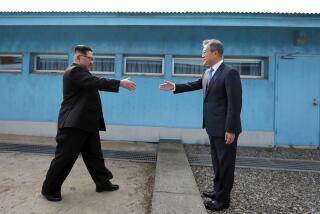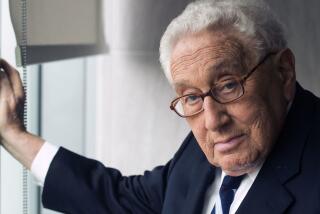The Washington Summit : But Seeds Were Planted at Glassboro in ’67 : Talks at Top: Risky Ventures
WASHINGTON — When President Lyndon B. Johnson and Soviet Premier Alexei N. Kosygin parted after their hastily arranged 1967 meeting at Glassboro, N.J., it appeared that another U.S.-Soviet summit had turned to ashes.
There was no agreement to describe for the hundreds of reporters who had rushed into the little college town. There was not even a joint statement. Kosygin drove back up the New Jersey Turnpike to New York, and the President took his helicopter back to Washington.
Later, the Soviet leader was reported to have said that the two days of talks accomplished “next to nothing.” At the White House, Johnson was glum. He hoped, he said, that the meeting had made the world a little safer.
As it turned out, the seemingly futile encounter at Glassboro planted the seeds for 20 years of on-again-off-again arms negotiations that have finally produced the first agreement to dismantle nuclear-tipped ballistic missiles.
Push for Arms Control
Although the Vietnam War and another explosive crisis in the Middle East brought Johnson and Kosygin to one dead end after another, the President and Defense Secretary Robert S. McNamara pushed hard on arms control issues--the possibility of a nuclear non-proliferation treaty and the United States’ rising alarm over Soviet deployment of defensive missiles to protect Moscow.
Within months, negotiators were laying the groundwork for a 1968 summit meeting in Moscow. Plans were set to announce on Aug. 21 that Johnson would visit Moscow in late September for a meeting that would lead to the first strategic arms limitation talks (SALT) between the nuclear superpowers.
But on Aug. 20, the Soviet Union led a Warsaw Pact invasion of Czechoslovakia, shattering the carefully laid plan and throwing the next U.S.-Soviet summit conference four years into the future.
For all the attention they have received, U.S.-Soviet summit meetings since World War II have proved to be risky ventures, laced with missed opportunities and demanding exquisite timing and choreography.
‘Dangerously Unstable’
The very process, author Michael Beschloss told the Eisenhower World Affairs Institute last year, “is a dangerously unstable element of American-Soviet relations.”
“The public demands a summit,” he said. “Both sides jockey into position. The leaders meet, determined to impress each other with their toughness or reason, as the times demand. Agreements are hammered out. Both sides run to the television cameras to put the best possible spin on their performance. If there is success, the public can be led to assume that disagreements between Washington and Moscow are over. If there is failure, it sometimes seems as if a new Cold War is about to begin, with no more summits for another four, five or six years.”
The checkered record of post-war summit meetings between U.S. and Soviet leaders began with Nikita S. Khrushchev’s visit to the United States in 1959. His meetings with President Dwight D. Eisenhower served mainly to produce agreement for an allied summit extravaganza in Paris in 1960, where Western leaders would home in on the problems of Germany, European security and disarmament.
David Eisenhower, the late President’s grandson and biographer, said Eisenhower came out of his Camp David talks with Khrushchev with mixed feelings about their worth and doubtful even then about the prospects for the planned super-summit meeting.
Khrushchev’s Tantrum
But two weeks before Eisenhower and Khrushchev joined British Prime Minister Harold Macmillan and French President Charles de Gaulle on May 16, 1960, an American U-2 spy plane was shot down over the Soviet Union. Khrushchev threw a tantrum on the first day of the summit, wrecking the meeting because Eisenhower would not publicly apologize and renounce future spy flights.
A year later, John F. Kennedy and Khrushchev took the measure of each other in Vienna. More than a quarter-century later, it is still argued by some that Khrushchev misjudged the young new American President and blundered into the Cuban missile crisis.
Political scientist Lloyd Etheredge of Yale University calls the Kennedy-Khrushchev encounter the “most consequential of the postwar summits.” It was, he said, a meeting at which the “aggressive and demanding” Khrushchev confronted Kennedy on the Berlin issue, sobered the President and “made him feel the United States had to stand up in other areas of the world.”
But Sovietologist and former diplomat Raymond L. Garthoff, of the Brookings Institution, said he doubts that the 1961 summit meeting led Khrushchev to install Soviet missiles in Cuba, providing the most serious confrontation of the nuclear age. It may, he said, have caused the Soviets to escalate the Berlin crisis.
‘A Lot Had Changed’
“Even if Khrushchev had a feeling that Kennedy was too young and inexperienced,” Garthoff said, “I think he would have modified that greatly as a result of the experience in the Berlin crisis. By the time of the Cuban missile crisis, a year and a half later, a lot had changed.”
In any event, there was not another U.S.-Soviet summit meeting until Johnson’s quickly arranged meeting with Kosygin in the home of the president of Glassboro State College.
The bright spot in Soviet-American summitry came in Richard M. Nixon’s meetings with Leonid I. Brezhnev in 1972, 1973 and 1974. Although the first produced the first strategic arms limitation treaty, curbing missile defense systems, and the second advanced efforts to control offensive arms, Nixon was undercut by the Watergate scandal.
When Brezhnev visited the United States in 1973, the Senate’s celebrated Watergate hearings were already under way. White House counsel John W. Dean’s sensational testimony implicating Nixon in the cover-up of the Watergate burglary was delayed until Brezhnev had gone home.
By the time Nixon went to Moscow the next year, his presidency was effectively wrecked, and he was only a little more than a month from resignation.
Vladivostok Summit
The groundwork for the SALT II pact, limiting offensive nuclear arms, was laid by Gerald R. Ford, Nixon’s successor, in a meeting with Brezhnev at Vladivostok. The agreement was finally concluded and signed by Brezhnev and President Jimmy Carter at Vienna in 1979.
In retrospect, arms control authorities look at the Carter period as one of missed opportunities. Carter was beset with political difficulties, and Brezhnev was ravaged by age and ill health.
“I think if President Carter had been stronger politically, we could have moved forward again right after SALT II,” said Paul C. Warnke, who was Carter’s chief arms negotiator. “He still had a year and a half to go, and I think the Russians were prepared to take bigger cuts.”
Warnke said a ranking Soviet official told him in 1977 that the Soviets were prepared to discuss substantial cuts in offensive missiles but that “Brezhnev had spilled a lot of political blood, and he had to have his Vladivostok treaty.”
In a marathon negotiating session with Ford and Secretary of State Henry A. Kissinger at Vladivostok, Brezhnev accepted the United States’ demand that the two countries have equal ceilings on offensive missile forces.
‘I Know We Agreed Otherwise’
According to Warnke, a member of the American negotiating team who is fluent in Russian overheard a Brezhnev telephone call back to Moscow from the Vladivostok conference room and heard the Soviet leader say, “I know we agreed otherwise, but I am going to accept the principle of equal ceilings.”
The principle was the core of the 1979 SALT II treaty signed by Carter and Brezhnev. But in the last days of the year, Soviet troops poured into Afghanistan to prop up an unpopular, pro-Soviet government in that country. Outrage in the United States was so great that the treaty was never ratified. Carter never met the Soviet leader at another summit conference.
Ronald Reagan, pushing history’s biggest peacetime military modernization, was in the White House nearly five years before he met the new Soviet leader, Mikhail S. Gorbachev in Geneva in 1985. When the leaders did meet, experts agree, it was at some risk because of the pressures mounting over the eight-year hiatus.
The get-acquainted session was successful, but in hindsight there is argument about whether the October, 1986, clash at Reykjavik, Iceland, which appeared to end in chaos, was a success or not.
Two-Track Agenda
“The Soviets came to Reykjavik with a two-track agenda,” said Stuart Goldman, a Soviet affairs analyst for the Congressional Research Service. “They were ready to do serious business but, failing that, they were prepared to turn it into a propaganda circus, ridiculing the ‘militaristic’ Reagan Administration. And, in the days after the meeting, they gave it their best shot, portraying the Strategic Defense Initiative as an obstacle to peace.”
In the end, however, the Administration succeeded in changing the perception. Europeans, jolted by the revelation that Reagan and Gorbachev had talked seriously of banning all ballistic missiles and seeing movement toward a denuclearized Europe, came to view SDI as the element that had saved them.
Goldman accepts the thesis that Gorbachev now aims at reducing tension abroad so that he can turn full force to his economic reforms at home.
“It may be,” he said, “that Gorbachev is willing to forgo for the indefinite future certain short-term advantages in East-West competition in order to achieve them. At the very least, there are really dramatic short-term possibilities. The real debate among Soviet specialists now is not whether Gorbachev is sincere but whether he can succeed in transforming the Soviet economic system and whether that is good or bad for U.S. interests.”
Looking Beyond INF
While Lyndon Johnson thought of using a summit meeting to launch the first SALT negotiations, Reagan and Gorbachev have opted to begin rather than end their meeting with the signing of the new treaty wiping out intermediate-range nuclear missiles.
It is a dramatic way of demonstrating that the Washington summit meeting looks beyond the INF agreement. Already there is preoccupation about rapidly concluding another pact to cut 50% of the long-range missile arsenals.
Experts who have watched U.S.-Soviet summits over the years inject a note of caution.
“There is a certain risk in planning that summit for next year,” Garthoff said, “not because they have to have an agreement each time but because they have both made it clear that they are striving to get one. Therefore, if they don’t, it means they fail, even though that is a very ambitious goal, and it shouldn’t be surprising if they are unable to wrap it up by then.”
On the other hand, there is a view that the time is right for Reagan.
“If he wants to get more than the INF treaty, he can do it,” Warnke said. “It would be harder for the next President because there are new people, you lose institutional memory and you always have to reinvent the wheel.”
More to Read
Sign up for Essential California
The most important California stories and recommendations in your inbox every morning.
You may occasionally receive promotional content from the Los Angeles Times.










